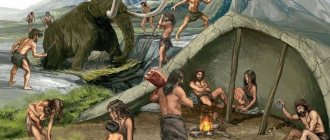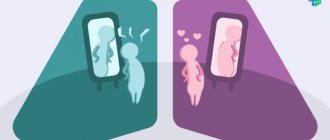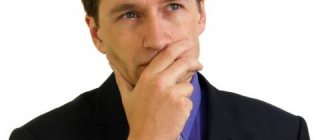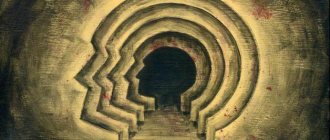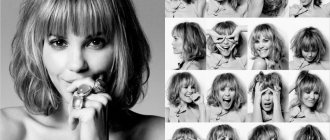Psychological characteristics of activity
Activity
- this is a specifically human activity regulated by consciousness, generated by needs and aimed at cognition and transformation of the external world and oneself.
Activity is a process of a person’s active relationship to reality, during which the subject achieves previously set goals, meets various needs and masters social experience (Fig. 1).
Rice. 1. Main features of the activity
The distinctive features of human activity are its social nature, purposefulness, planning, and systematicity (Fig. 2).
Rice. 2. Features of the activity
The main characteristics of human activity are objectivity and subjectivity (Fig. 3).
Rice. 3. Characteristics of activity
When analyzing activity, three plans for its consideration are distinguished: genetic, structural-functional and dynamic (Fig. 4).
5 pages, 2232 words
Psychological assistance to children with mental retardation...
... characteristics of perception. Research by representatives of cognitive psychology has proven the relationship between methods of perception and a person’s personal organization. ... forms manifest themselves in different ways. Psychological parameters of mental retardation ... with impairments of intellectual activity and prerequisites for intelligence, ... K. S. Lebedinskaya distinguishes four main variants of mental retardation: - constitutional origin; ...
Key Aspects of Performance Analysis
The initial form of any human activity is social joint activity, and the mechanism of development of the psyche is internalization, during which the transition from external to internal activity occurs.
Genetic
This consideration is based on the principle of analysis “by units”: the decomposition of reality into “units” containing the basic properties inherent in it as a whole. Hierarchical relationships between units of activity are mobile, and depending on the place of the reflected object in the structure of activity, the content of mental reflection changes
Structural-functional
When considering activity, the mechanisms that ensure the movement of the activity itself are studied: supra-situational activity, which determines the self-development of activity and the emergence of its new forms; an attitude that determines the stability of purposeful activity in a changing reality
Dynamic
Rice. 4. Aspects of performance analysis
Forms
A mentally healthy person should equally develop:
- Sensation is a reflection of the surrounding world using the senses. Helps to navigate the environment.
- Perception - recognizing an object, forming an image of an object.
- Representation is the recreation of an image of an object that does not affect the senses. Representation is impossible if memory and thinking are impaired.
- Thinking is a process necessary for collecting, storing information, and reproducing it. Participates in the operation of other processes.
- Attention is a response to a stimulus directed at an object. Directed attention is an active process of research and selection of information.
- Will is the level of expression of aspiration. Necessary to achieve the goal.
The development of individual forms occurs unevenly. The foundations and developmental trends are laid in childhood. If one form is not developed enough, it will negatively affect the others. Memory problems affect thinking, lack of will affects perception.
Activity structure
In the structure of activity, one should, first of all, distinguish between the subject and the object of activity. Subject
- the one who carries out the activity,
the object
is what it is aimed at. The subject of the activity can be a person, a group of people, an organization, or a government body. The object can be natural materials, various objects, spheres or areas of people's lives. The subject's activity can also be directed at another person.
9 pages, 4079 words
Case No. 37 Psychology of a primary school student. Leading activities...
... still get 4 and 5. 2 situation. Game is the main activity of a primary school student. It should be carried out as plot-based role-playing games, where ... to other people - adults, peers, to the tasks that he performs, and to the extent to which he has developed the mental qualities necessary ... attitude towards language. With training, he easily masters the sound analysis of words. The child listens to the sound of the word. Need in …
Activity is the internal (mental) and external (physical) activity of a person, regulated by a conscious goal.
Further in the structure of activity one can distinguish: motives, goals, methods and techniques, goal (Fig. 5).
Rice. 5. Activity structure
Motives
– those internal goals that are related to the needs of the individual and encourage him to perform certain activities. The motive of an activity is what prompts it, for the sake of which it is carried out.
The motives of human activity can be very different: organic, functional, material, social, spiritual.
Organic motives are aimed at satisfying the natural needs of the body (in humans, at creating conditions that are most conducive to this).
Such motives are associated with growth, self-preservation and development of the organism. This is the production of food, housing, clothing, etc. Functional motives are satisfied through various cultural forms of activity, such as games and sports. Material motives encourage a person to engage in activities aimed at creating household items, various things and tools, directly in the form of products that serve natural needs. Social motives give rise to various types of activities aimed at taking a certain place in society, gaining recognition and respect from those around them. Spiritual motives underlie those activities that are associated with human self-improvement. The type of activity is usually determined by its dominant motive (dominant because all human activity is polymotivated, that is, motivated by several different motives).
The motivation of activity during its development does not remain unchanged. So, for example, over time, other motives for work or creative activity may appear, and the previous ones fade into the background. Sometimes an action that was previously included in an activity can stand out from it and acquire an independent status, turning into an activity with its own motive. In this case, we note the fact of the birth of a new activity.
With age, as a person develops, the motivation for his activities changes. If a person changes as a person, then the motives of his activities are transformed. The progressive development of man is characterized by the movement of motives towards their increasing spiritualization (from organic to material, from material to social, from social to creative, from creative to moral).
4 pp., 1687 words
The structure of human motives
…Activity is directed by motive. The activity is multi-motivated. Conventionally, we can say that activity has a leading motive. The components of activity are actions. Actions are subordinated to a conscious goal. There are two definitions of action. The first is genetic determination. Action is a process, a motive and a goal...
Motive and goal form a kind of vector of activity that determines its direction, as well as the amount of effort developed by the subject during its implementation. This vector organizes the entire system of mental processes and states that are formed and unfold in the course of activity.
Goals
– the most significant objects, phenomena, tasks and objects for a person, the achievement and possession of which constitute the essence of his activity.
The goal of an activity is an ideal representation of its future result. goal of an activity
is its product. It can represent a real physical object created by a person, certain knowledge, skills and abilities acquired in the course of activity, a creative result (thought, idea, theory, work of art).
The purpose of an activity is not equivalent to its motive, although sometimes the motive and purpose of an activity may coincide with each other. Different activities that have the same goal (end result) can be stimulated and supported by different motives. On the contrary, the same motives may underlie a number of activities with different ultimate goals. For example,
Reading a book for a person can act as a means of satisfying material (to demonstrate knowledge and get a well-paid job for this), social (to show off your knowledge among significant people, to achieve their favor), spiritual (to broaden your horizons, rise to a higher level of moral development) needs . Such different types of activities as purchasing fashionable, prestigious things, reading literature, taking care of appearance, developing the ability to behave, can ultimately pursue the same goal: to achieve someone’s favor at all costs.
It is necessary to distinguish between the final goal and intermediate goals. Achieving the ultimate goal is tantamount to satisfying a need. Intermediate goals include those set by a person as a condition for achieving the final goal.
Goals can be close and distant, personal and public, depending on what significance a person attaches to them and what role his activities play in public life. The goal is determined more accurately, the better the subject of the activity knows what the means and conditions for achieving the goal are.
Methods and techniques
(actions) – relatively complete elements of activity aimed at achieving intermediate goals, subordinated to a common motive.
A complex external action for its implementation may require a number of acts related to each other in a certain way. These acts or links into which the action is divided are operations.
Every activity includes internal and external components. In its origin, internal (mental, mental) activity is derived from external (objective) activity.
Initially, objective actions are performed and only then, as experience accumulates, a person acquires the ability to perform the same actions in the mind. The transfer of external action to the internal plane is called internalization.
Mastering internal activities leads to the fact that before embarking on external activities aimed at achieving the desired goal, a person carries out actions in the mind, operating with images and speech symbols. External activity in this case is prepared and proceeds on the basis of the performance of mental activity. The implementation of mental action externally, in the form of actions with objects, is called exteriorization.
12 pages, 5595 words
1 The role of science in the development of society. Scientific activity, scientific knowledge
... studies, a phenomenon of the surrounding world to which the scientist’s attention is directed; 3) the goal of scientific activity is to obtain objective knowledge about the object of research; 4) empirical and theoretical methods of scientific knowledge... in science the principles and methods of knowledge, as well as obtaining results useful for human activity, implementation in production with further effect. The basis for the development of each...
Operation
name the method of carrying out an action. As many different ways of performing an action as there are, so many different operations can be distinguished. The nature of the operation depends on the conditions for performing the action, on the skills and abilities a person has, on the available tools and means of carrying out the action. Different people, for example, remember information and write differently. This means that they carry out the action of writing text or memorizing material using various operations. A person’s preferred operations characterize his individual style of activity.
Activities are carried out in the form of a system of actions. Action is the main structural unit of activity, which is defined as a process aimed at achieving a goal (Fig. 6).
There are practical (objective) and mental actions (Fig. 7).
Main characteristics of the action
Includes as a necessary component an act of consciousness in the form of setting and maintaining a goal
Action is at the same time an act of behavior, but external movements are considered in inextricable unity with consciousness
Through the concept of action, the principle of activity is affirmed, opposed to the principle of reactivity.
The concept of “action” brings human activity into the objective and social world
Rice. 6. Action characteristics
Rice. 7. Types of actions
12 pp., 5695 words
Expand the concept of knowledge, skills, abilities. Identify psychological...
...activities and ever-expanding experiences of children. A game is a form of activity in conditional situations in which typical actions and forms of interaction between people are reproduced. Role-playing game is an activity... I.e. a skill is a partially automated action. Another definition: a skill is a way of performing actions that has become automated as a result of the exercise. Skills and abilities …
In each action, one can distinguish indicative, executive and control parts (Fig. 8).
Rice. 8. Action structure
What is it in psychology
The first concept was developed by N.A. Leontiev in Soviet times. He first presented his theory in the 1940s, after which he repeatedly refined and changed it.
In the understanding of N.A. Leontief activity is defined in psychology as follows: the term refers to a system of active actions that is aimed at satisfying a need. It obeys the motive and is realized by man.
Important! The concept of “activity” should not be confused with “activity” - these are two different phenomena.
Other psychologists developed N.A.’s idea. Leontyev. Domestic specialists, S. L. Rubinstein and L. S. Vygotsky, also complemented the theory.
Mastering the activity. Knowledge, skills, abilities
Knowledge.
Human knowledge about the world appears initially in the form of images, sensations and perceptions. Processing of sensory data about consciousness leads to the formation of ideas and concepts. In these two forms, knowledge is stored in memory. Their main purpose is to organize and regulate practical activities. Knowledge and action are closely interconnected. Actions with objects give a person knowledge both about their properties and about the possibilities of handling them. When faced with an unfamiliar object, a person strives first of all to gain knowledge of how to act with it, how to use it. Knowledge raises an activity to a higher level of awareness and increases a person's confidence in the correctness of its implementation. When carrying out an activity, a person interacts with the objective (real or mental) world: the objective situation is transformed, certain objective situations are created, and intermediate results are achieved. Each operation in the structure of action is determined by the conditions of the changing situation, as well as the skills of the subject of the activity.
A skill
is
a stereotyped way of performing individual actions - operations, formed as a result of their repeated repetition and characterized by the collapse (reduction) of its conscious control. This is a chain of operations fixed in repetition, united through a common function. There are simple and complex skills (Fig. 9).
Types of skills
Simple
Simple techniques and actions performed automatically, without sufficient concentration
6 pages, 2915 words
Human emotional intelligence and ability to manage emotions
... manage emotions than others. What is the reason for this phenomenon? What human characteristics provide the ability to manage emotions? In the literature, there are two types of theories of EI - mixed... with different aspects of reality, arising from the entire history of human development, expressing his personal experience, internally determining his actions and experiences.” In the context of this study, of particular importance...
Learned automated motor, perceptual and intellectual complex actions, performed accurately, easily and quickly with little effort of consciousness and ensuring the effectiveness of human activity
Complex
Automated influence on an external object using movements in order to transform it, which has been carried out repeatedly previously
Motor
Automated sensory reflection of the properties and characteristics of a well-known object that has been repeatedly perceived before
Perceptual
Automated reception, a way to solve a previously encountered problem
Intellectual
Rice. 9. Types of skills
Skills are formed through exercise, i.e. purposeful and systematic repetitions of actions (Fig. 10).
As the exercise progresses, both quantitative and qualitative performance indicators change. A skill arises and functions as an automated technique for performing an action. Its role is to free consciousness from control over the implementation of action techniques and switch it to the goals and conditions of action.
Rice. 10. Main stages of skill formation
The success of mastering a skill depends not only on the number of repetitions, but also on other reasons of an objective and subjective nature. Since many skills are included in the structure of actions and various activities, they usually interact with each other to form complex systems. The nature of their interaction can be different: from coordination to opposition, from complete fusion to mutually negative influence (Fig. 11).
4 pp., 1797 words
Studying the specific features of the gaming activity of an adult
... children's play, theoretical and philosophical aspects of play activity in adults, empirical research on adult play, as well as the connection between adult play activity and... play). This is a deliberate series of actions pursuing a specific goal, intrigue, secret plans. We are talking about a play of imagination, a play of nature, a play of words, a play of chance, a play of fate. In essence, what a person...
To maintain a skill, it should be used systematically, otherwise deautomation occurs,
those. weakening or almost complete destruction of developed automatisms. With deautomation, movements become slower and less accurate, coordination is impaired, movements begin to be performed uncertainly, and require special concentration and increased conscious control.
Skill
is a method of performing actions mastered by a subject, provided by a set of acquired knowledge and skills.
Rice. 11. Skill interaction
Skills are formed as a result of the coordination of skills, their integration into systems through actions that are under conscious control. Through the regulation of such actions, optimal management of skills is carried out, which should ensure error-free and flexible execution of the action. One of the main qualities of skills is that a person is able to change their structure (skills, operations and actions included in the skills, the sequence of their implementation), while maintaining the same final result. Skills are based on active intellectual activity and necessarily include thinking processes. Conscious intellectual control is the main thing that distinguishes skills from skills. Activation of intellectual activity in skills occurs at those moments when the conditions of activity change, non-standard situations arise that require prompt adoption of various decisions.
Skills are divided into several types: motor, cognitive, theoretical and practical. Motor
include a variety of movements, complex and simple, components of external, motor aspects of activity.
Cognitive skills
include abilities associated with searching, perceiving, remembering and processing information.
They correlate with basic mental processes and involve the formation of knowledge. Theoretical skills
are associated with abstract intelligence. They are expressed in a person’s ability to analyze, generalize material, build hypotheses, theories, and translate information from one sign system to another. Such skills and abilities are most manifested in creative work associated with obtaining an ideal product of thought.
are of great importance in the formation of all types of skills .
Thanks to them, skills are automated, skills are improved, and activities in general are improved. Exercises are necessary both at the stage of developing skills and abilities, and in the process of maintaining them. Without constant, systematic exercise, skills and abilities are usually lost and lose their qualities.
11 pages, 5055 words
Testing and assessing the knowledge, skills and abilities of primary school students
... junior grades 1.1 The concept of assessing knowledge, skills and abilities control achievement assessment student Assessment is the process, activity (action) of assessment to establish the degree of real... subject, general academic and intellectual skills and abilities, universal competencies, including individual educational parameters and personal components of leaders human spheres, collectively reflecting and...
Another element of activity is habit.
It differs from ability and skills in that it represents a so-called unproductive element of activity. If skills and abilities are related to solving a problem, involve obtaining a product and are quite flexible (in the structure of complex skills), then habits are an inflexible (often unreasonable) part of an activity that a person performs mechanically and does not have a conscious goal or clearly expressed productive completion. Unlike a simple skill, a habit can be consciously controlled to a certain extent. But it differs from skill in that it is not always reasonable and useful (bad habits).
Habits as elements of activity are the least flexible parts of it.
Individual style
Many psychologists emphasize that any personality theory has fairly general characteristics. Therefore, you always need to take into account the characteristics of a particular person.
Individual style includes temperament, experience, skills, knowledge. All this is developed at different levels in each individual. Therefore, achieving the same goal cannot be the same.
The person also chooses which techniques to use to implement the plan. They may be chosen incorrectly, then the individual analyzes his activities, finds mistakes and does not make them again.
Manifestations of temperament can also be considered an individual style. Despite the fact that the structure of the nervous system is the same for all people, the ratio of the processes of excitation and inhibition will be different. A phlegmatic person takes longer to work, but has less risk of making a mistake due to inattention. It is easier for a sanguine person to cope with several things. The human body is designed in a complex way. Many of its functions are formed only under the influence of the external environment.
Children do not think twice and imitate the behavior of adults, this influences the formation of style
At school age, a child learns self-control and reflection. An adult is influenced by the professional sphere; the development of an individual style of activity depends on it.
Main activities
The emergence and development of various types of human activity is a complex and lengthy process. There are three types of activity that genetically replace each other and coexist throughout a person’s life: play, learning, and work. They differ in final results (product of activity), organization and characteristics of motivation.
A game
– a form of human activity in conditional situations, aimed at recreating and assimilating social experience, fixed in socially fixed ways of carrying out objective actions. There are several types of games (Fig. 12).
Often in life there are mixed types of games: subject-role-playing, plot-role-playing, plot-based games with rules, etc.
Games are often of an entertainment nature and serve the purpose of relaxation. Sometimes games serve as a means of symbolic release of tensions that have arisen under the influence of the actual needs of a person, which he is unable to weaken in any other way.
Rice. 7.12. Types of games
There are several types of games: individual and group, subject and plot, role-playing and games with rules. Individual games
represent a type of activity when one person is engaged in the game,
group
include several individuals.
Object games
are associated with the inclusion of any objects in a person’s play activity.
Story games
unfold according to a certain scenario, reproducing it in basic detail.
Role-playing games
allow human behavior limited to a specific role that he takes on in the game.
Finally, games with rules
are governed by a certain system of rules of conduct for their participants. Often in life there are mixed types of games: subject-role-playing, plot-role-playing, plot-based games with rules, etc. The relationships that develop between people in a game, as a rule, are artificial in the sense of the word that those around them are not taken seriously and are not the basis for drawing conclusions about a person. Gaming behavior and gaming relationships have little effect on real relationships between people, at least among adults.
However, games are of great importance in people's lives. For children, games have primarily a developmental value, and for adults they serve as a means of communication and relaxation.
Teaching
is a type of activity whose purpose is to acquire knowledge, skills and abilities by a person.
The main goal of learning is preparation for future independent work, and the main means is mastering the generalized results of what was created by previous work. The teaching consists of the following components:
- assimilation of information about the properties of surrounding objects and phenomena (knowledge);
- mastering the techniques and operations from which the main types of activities (skills) are formed;
- mastering ways of using information for the correct selection of techniques and operations in accordance with the goals and conditions of activity (skills).
Teaching can be organized and carried out in special educational institutions. It can be unorganized and occur along the way, in other types of activities as their by-product, additional result.
Historically, the primary type of human activity is labor. Work as a whole is not a psychological, but a social category. The subject of psychological study is not work as a whole, but only the psychological components of work activity.
Work
– this is an activity aimed at creating a socially useful product that satisfies the material or spiritual needs of people.
At the same time, work directed in accordance with one’s intention to create a certain result is the main way of personality formation. In the labor process, not only is this or that product of the subject’s labor activity born, but the subject itself is formed. In work, not only its technique is important, but also the person’s attitude towards work. It contains the main motives for human labor activity. This subjective attitude towards work is determined by the urgent needs of a person. To work means to express oneself in activity. All aspects of personality manifestation are reflected in work. Each type of work has its own more or less complex technique that must be mastered. Therefore, knowledge and skills always play a certain role in work. Without knowledge and skills, no work is possible. Human activity is a complex and diverse phenomenon. All components of a person’s hierarchical structure are involved in the implementation of activities: physiological, mental and social.
When they talk about the development of human activity, they mean the following aspects of its progressive transformation:
1. Phylogenetic development of the human activity system.
2. Inclusion of a person in various types of activities in the process of his individual development (ontogenesis).
3. Changes occurring within individual activities as they develop.
4. Differentiation of activities, in the process of which others are born from some activities due to the isolation and transformation of individual actions into independent types of activity.
The phylogenetic transformation of the system of human activities essentially coincides with the history of the socio-economic development of mankind. Integration and differentiation of social structures were accompanied by the emergence of new types of activities among people. The same thing happened as the economy grew, cooperation and division of labor developed. People of new generations, joining the life of their contemporary society, assimilated and developed those types of activities that are characteristic of this society.
This process of integrating the growing individual into the existing system of activities is called socialization,
and its gradual implementation involves the gradual involvement of the child in communication, play, learning and work - those four main types of activities that were briefly described above. Moreover, each of these types of activities is first learned in its most elementary form, and then becomes more complex and improved. The communication of an adult with the people around him is no more similar to the communication of a baby or a primary school student than the work activity of adults is to a child’s game.
Afterword
Conscious purposeful activity is the difference between people and animals. In its process, a person creates objects of material and spiritual culture, transforms his abilities, ensures progress (although sometimes regression) of society, influences nature (preserves or destroys).
Any activity is a creative way beyond the natural, work on oneself and the world. Man not only consumes, but also creates. With her help he influences his life.
Thanks to it, the mental development of the individual is carried out. However, at the same time, mental processes (perception, attention, imagination, memory, thinking, speech) act as components and even separate types of activity.
Modern psychological science is based on such basic concepts as “personality”, “consciousness”, “activity”, “communication”. Often the concept of activity in psychology is interpreted as a unique form of the subject’s relationship to the world around him. Moreover, this attitude is conscious, aimed at its development and transformation to the extent that it seems appropriate to the individual. The role of consciousness depends on the type of activity - in scientific, work or play, its psychological component is different.
Activity is recognized as the basis for personality formation.
Articles on the topic
- The tasks of modern psychology in the field of development and formation of human personality
- Problems of modern psychology - science is plunging into crisis
- Methodological principles of psychology: current methods that allow you to study everything
- Corporate relations in modern society
A purposeful attitude towards the world is realized in the following types: cognitive, evaluative, spiritual or material, reproductive, creative and many others.
Structure of educational activities
In the external structure of educational activities, the following main components are distinguished: motivation; educational tasks in certain situations in different forms; learning activities; control turning into self-control; assessment that turns into self-esteem.
Motivation is a determining component of the structural organization of educational activities; it can be internal or external relative to the activity, but it is always an internal characteristic of the individual as the subject of this activity.
The main morphological unit of educational activity is the educational task. Its main difference from other tasks is that its goal and result is to change the subject, and not the objects with which he acts (D. Elkonin).
Learning activities can be presented in the form of a system of learning tasks. They are set in certain educational situations and provide for certain educational actions - subject, control and auxiliary (technical) actions, such as analysis, generalization, schematization, underlining, and the like.
Study assignment
is a systemic education in which two components are required: the subject of the task in the initial state and the model of the state of the subject of the task that must be achieved (G. Point).
E. Mashbits identified the following basic psychological requirements for educational tasks, determined by their place in educational activities and the relationship between educational tasks and educational goals:
1) designing not just any individual task, but a combination of them;
2) when designing such a system of tasks, it is necessary to ensure that it ensures the achievement of not only immediate, but also distant educational goals;
3) educational tasks must ensure the assimilation of a system of means necessary and sufficient for the successful implementation of educational activities;
4) the educational task must be designed in such a way that the means of activity, the assimilation of which is provided for in the process of solving the task, play the role of a direct product of learning.
An important morphological unit of educational activity is also the educational actions from which it is composed. An action is a process whose motive does not coincide with its object (that is, with what it is aimed at), but lies in the plane in which this action enters.
Conscious purposeful actions, which are repeated many times and enter into a more complex action, gradually cease to be the object of conscious control and turn into more complex actions, that is, operations.
The effectiveness of educational activities depends on the volume and lability of the formed methods of action. Methods of action are a system of operations that should “discover” those properties and qualities of the subject of action in relation to which its transformation is carried out to achieve the goal.
In the actions with the help of which educational activities are carried out, there are indicative, performing and control parts.
To the approximate part
actions include a model of an object, a model of action (algorithm and its operations), selection and characteristics of the material with which the student will work, characteristics and selection of operations or tools for their use, means and operations of control, combining all these points into one action plan.
Performing part
action provides a direct transfer of the object of assimilation from one state to another. The nature of such a translation is determined by the relationships between objects that correspond to a given action. These relations are always meaningful, objective, and therefore they are divided into mathematical, grammatical, etc.
Control part
action checks the correctness of the action product and the method of achieving it.
In the general structure of educational activities, control (self-control) and assessment (self-assessment) actions also play a significant role.
This is due to the fact that any action becomes arbitrary and regulated only if there is control and evaluation in the structure of the activity.
17
Examples of similar educational works
The effectiveness of psychological and pedagogical conditions for the formation of labor skills in children...
... skills and abilities require the participation of the entire personality of the preschooler: his mental processes, states and properties. With the help of mental processes, for example, a person navigates working conditions, forms a goal, and controls the progress of activities. ...
Skills and abilities in the preschool education system
... the student turns to the rule in order to control the action being performed or when working on mistakes made. Skills are automated components of a person’s conscious action that are developed in the process of…
Reporting documentation on practice. Practice to obtain primary skills and abilities...
... practice Practice for obtaining primary skills and abilities in research activities _________ (full name of the trainee No. ... nbsp; Topic of the lesson (lesson)_______________________________________________ Goal and objectives (educational, developmental, ...
Place of training practice for obtaining primary professional skills in the educational program of higher professional education
... The purpose of educational practice to obtain primary professional skills: promoting the professional self-determination of students, familiarizing students with the activities of ... humans; their manifestations in various areas of human activity...
Human emotional intelligence and ability to manage emotions
... What human characteristics provide the ability to manage emotions? ... of a person, expressing his personal experience, internally determining his actions ... what motive underlies human behavior. ... of little use and inadequate to the purposes of the study. Emotional...
Subject and principles
Behaviorism is in psychology, briefly and clearly.
Activity is always aimed at something or someone, i.e. it cannot be pointless. Scientists identify two main principles:
- Functionality - a person relies on already developed mental elements and mobilizes forces to achieve a goal.
- Systematicity - activity always has a certain structure, it is influenced by the individual qualities of the individual.
Psychological activity is of great importance, as it makes it possible to understand the peculiarities of the functioning of the human personality.



